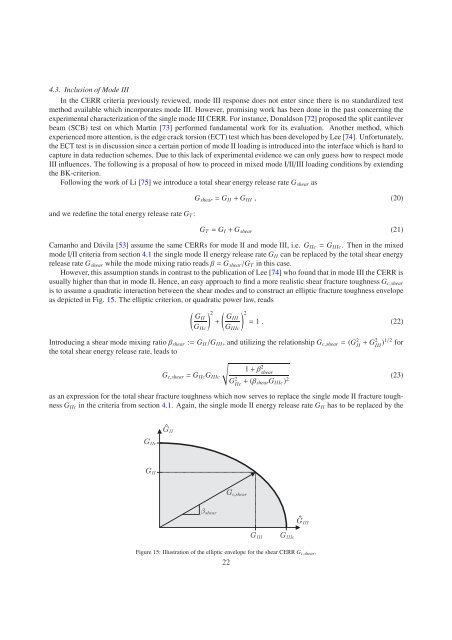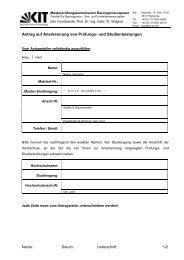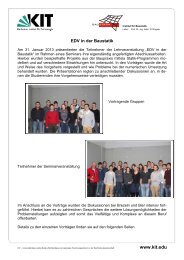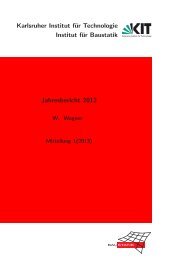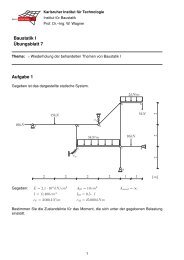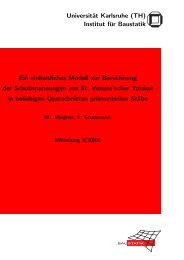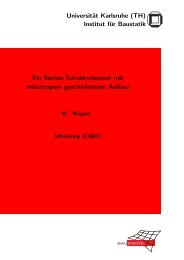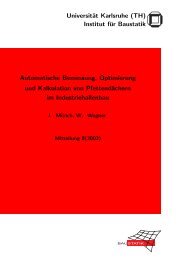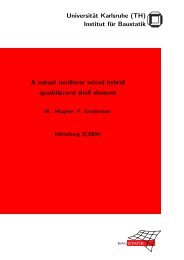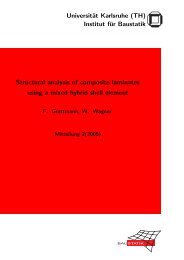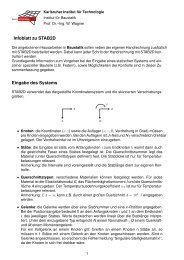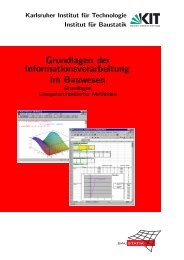Karlsruher Institut für Technologie Institut für Baustatik Adhesive ...
Karlsruher Institut für Technologie Institut für Baustatik Adhesive ...
Karlsruher Institut für Technologie Institut für Baustatik Adhesive ...
- No tags were found...
You also want an ePaper? Increase the reach of your titles
YUMPU automatically turns print PDFs into web optimized ePapers that Google loves.
4.3. Inclusion of Mode IIIIn the CERR criteria previously reviewed, mode III response does not enter since there is no standardized testmethod available which incorporates mode III. However, promising work has been done in the past concerning theexperimental characterization of the single mode III CERR. For instance, Donaldson [72] proposed the split cantileverbeam (SCB) test on which Martin [73] performed fundamental work for its evaluation. Another method, whichexperienced more attention, is the edge crack torsion (ECT) test which has been developed by Lee [74]. Unfortunately,the ECT test is in discussion since a certain portion of mode II loading is introduced into the interface which is hard tocapture in data reduction schemes. Due to this lack of experimental evidence we can only guess how to respect modeIII influences. The following is a proposal of how to proceed in mixed mode I/II/III loading conditions by extendingthe BK-criterion.Following the work of Li [75] we introduce a total shear energy release rate G shear asand we redefine the total energy release rate G T :G shear = G II + G III , (20)G T = G I + G shear (21)Camanho and Dávila [53] assume the same CERRs for mode II and mode III, i.e. G IIc = G IIIc . Theninthemixedmode I/II criteria from section 4.1 the single mode II energy release rate G II can be replaced by the total shear energyrelease rate G shear while the mode mixing ratio reads β = G shear /G T in this case.However, this assumption stands in contrast to the publication of Lee [74] who found that in mode III the CERR isusually higher than that in mode II. Hence, an easy approach to find a more realistic shear fracture toughness G c,shearis to assume a quadratic interaction between the shear modes and to construct an elliptic fracture toughness envelopeas depicted in Fig. 15. The elliptic criterion, or quadratic power law, reads( ) 2 ( ) 2 GII GIII+ = 1 . (22)G IIc G IIIcIntroducing a shear mode mixing ratio β shear := G II /G III , and utilizing the relationship G c,shear = (G 2 II + G2 III )1/2 forthe total shear energy release rate, leads to√1 + β 2 shearG c,shear = G IIc G IIIcG 2 IIc + (β (23)shearG IIIc ) 2as an expression for the total shear fracture toughness which now serves to replace the single mode II fracture toughnessG IIc in the criteria from section 4.1. Again, the single mode II energy release rate G II has to be replaced by the^G IIG IIcG IIshearG cshear ,^G IIIG IIIG IIIcFigure 15: Illustration of the elliptic envelope for the shear CERR G c,shear .22


